JavaScript is disabled for your browser. Some features of this site may not work without it.
Buscar en RiuNet
Listar
Mi cuenta
Estadísticas
Ayuda RiuNet
Admin. UPV
HS-SPME analysis of the volatiles profile of water celery (Apium nodiflorum), a wild vegetable with increasing culinary interest
Mostrar el registro sencillo del ítem
Ficheros en el ítem
| dc.contributor.author | Guijarro-Real, Carla
|
es_ES |
| dc.contributor.author | Rodríguez Burruezo, Adrián
|
es_ES |
| dc.contributor.author | Prohens Tomás, Jaime
|
es_ES |
| dc.contributor.author | Raigón Jiménez, Mª Dolores
|
es_ES |
| dc.contributor.author | Fita, Ana
|
es_ES |
| dc.date.accessioned | 2020-12-03T04:31:44Z | |
| dc.date.available | 2020-12-03T04:31:44Z | |
| dc.date.issued | 2019-07 | es_ES |
| dc.identifier.issn | 0963-9969 | es_ES |
| dc.identifier.uri | http://hdl.handle.net/10251/156321 | |
| dc.description.abstract | [EN] Water celery (Apium nodiflorum) is a wild plant traditionally harvested in some Mediterranean areas for being consumed raw. Despite its appreciated organoleptic properties, the aromatic profile of the fresh vegetable remains to be studied. In the present study, volatile compounds from five wild populations were extracted by the headspace-solid phase microextraction technique, analysed by gas cromatography-mass spectrometry, and compared to related crops. The wild species had a high number of aromatic compounds. It was rich in monoterpenes (49.2%), sesquiterpenes (39.4%) and phenylpropanoids (9.6%), with quantitative differences among populations, in absolute terms and relative abundance. On average, germacrene D was the main compound (16.6%), followed by allo-ocimene (11.9%) and limonene (11.1%). Only in one population, the levels of limonene were greater than those of germacrene D. Among phenylpropanoids, dillapiol displayed the highest levels, and co-occurred with myristicin in all populations except one. These differences may have a genetic component, which would indicate the possibility of establishing selection programmes for the development of water celery as a crop adapted to different market preferences. On the other hand, comparison with related crops revealed some similarities among individual volatiles present in the different crops, which would be responsible of the common aroma notes. However, water celery displayed a unique profile, which was in addition quantitatively richer than others. Thus, this differentiation may promote the use of water celery as a new crop. | es_ES |
| dc.description.sponsorship | C. Guijarro-Real thanks the Ministerio de Educacion, Cultura y Deporte of Spain (MECD) for the financial support with a predoctoral FPU grant (FPU14-06798). Authors also thank Manuel Figueroa for his unvaluable ethnobotanical knowledge and advice, as well as his support in the survey of water celery in the Horta Nord shire | es_ES |
| dc.language | Inglés | es_ES |
| dc.publisher | Elsevier | es_ES |
| dc.relation.ispartof | Food Research International | es_ES |
| dc.rights | Reserva de todos los derechos | es_ES |
| dc.subject | Aroma | es_ES |
| dc.subject | Carrot | es_ES |
| dc.subject | Celery | es_ES |
| dc.subject | Diversity | es_ES |
| dc.subject | Fool's watercress | es_ES |
| dc.subject | Parsley | es_ES |
| dc.subject | Phenylpropanoids | es_ES |
| dc.subject | Sesquiterpenes | es_ES |
| dc.subject.classification | EDAFOLOGIA Y QUIMICA AGRICOLA | es_ES |
| dc.subject.classification | GENETICA | es_ES |
| dc.title | HS-SPME analysis of the volatiles profile of water celery (Apium nodiflorum), a wild vegetable with increasing culinary interest | es_ES |
| dc.type | Artículo | es_ES |
| dc.identifier.doi | 10.1016/j.foodres.2018.12.054 | es_ES |
| dc.relation.projectID | info:eu-repo/grantAgreement/MECD//FPU2014-06798/ES/FPU2014-06798/ | es_ES |
| dc.rights.accessRights | Abierto | es_ES |
| dc.contributor.affiliation | Universitat Politècnica de València. Departamento de Biotecnología - Departament de Biotecnologia | es_ES |
| dc.contributor.affiliation | Universitat Politècnica de València. Departamento de Química - Departament de Química | es_ES |
| dc.description.bibliographicCitation | Guijarro-Real, C.; Rodríguez Burruezo, A.; Prohens Tomás, J.; Raigón Jiménez, MD.; Fita, A. (2019). HS-SPME analysis of the volatiles profile of water celery (Apium nodiflorum), a wild vegetable with increasing culinary interest. Food Research International. 121:765-775. https://doi.org/10.1016/j.foodres.2018.12.054 | es_ES |
| dc.description.accrualMethod | S | es_ES |
| dc.relation.publisherversion | https://doi.org/10.1016/j.foodres.2018.12.054 | es_ES |
| dc.description.upvformatpinicio | 765 | es_ES |
| dc.description.upvformatpfin | 775 | es_ES |
| dc.type.version | info:eu-repo/semantics/publishedVersion | es_ES |
| dc.description.volume | 121 | es_ES |
| dc.identifier.pmid | 31108807 | es_ES |
| dc.relation.pasarela | S\382240 | es_ES |
| dc.contributor.funder | Ministerio de Educación, Cultura y Deporte | es_ES |







![[Cerrado]](/themes/UPV/images/candado.png)

